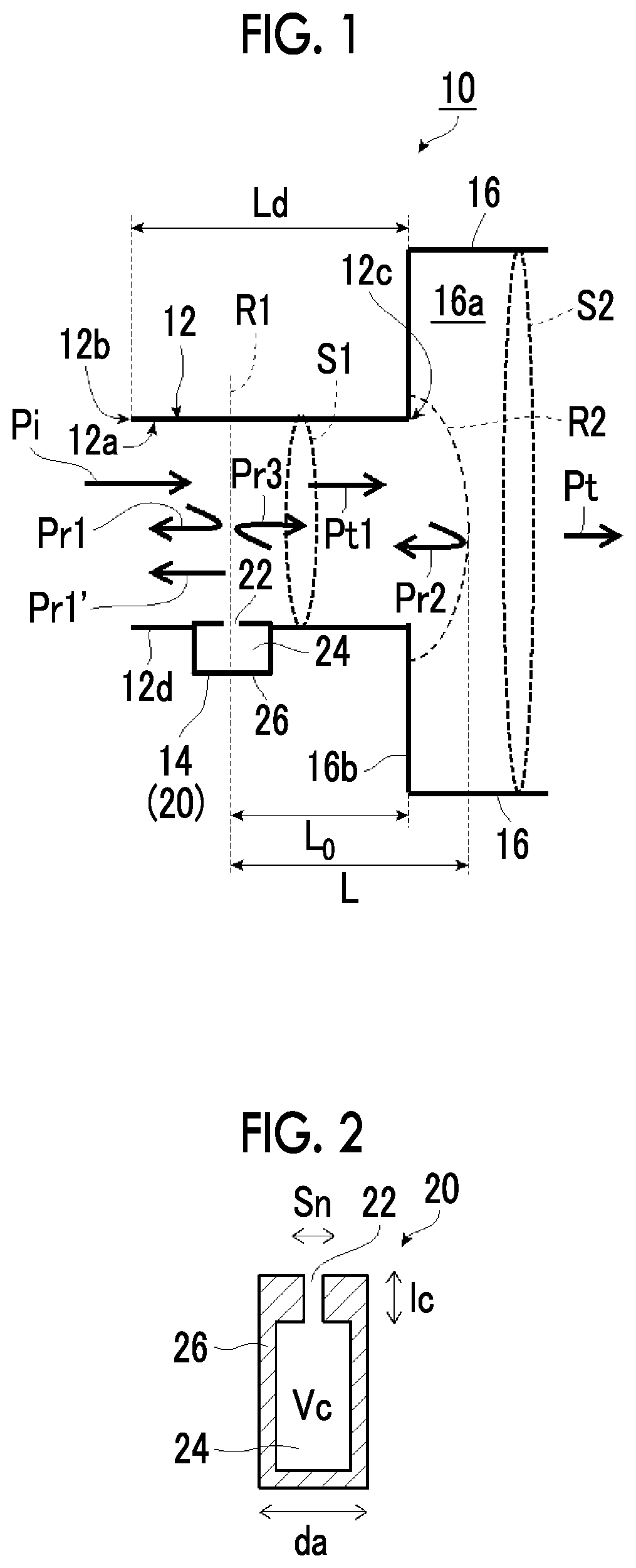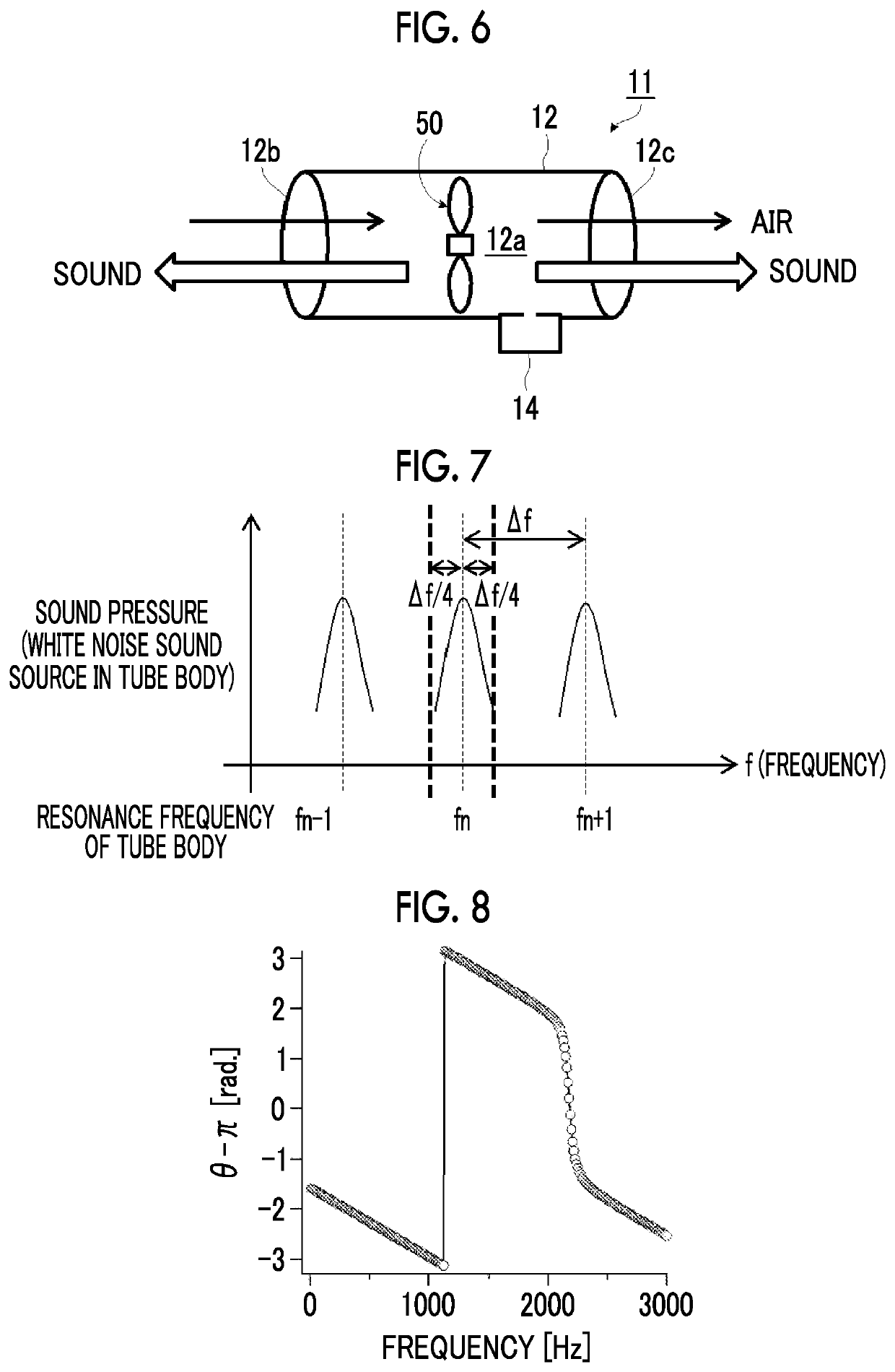Soundproof structure body
- Summary
- Abstract
- Description
- Claims
- Application Information
AI Technical Summary
Benefits of technology
Problems solved by technology
Method used
Image
Examples
example 1
[0237]First, a soundproof structure body 10 according to the embodiment of the present invention illustrated in FIG. 1 was used as Example 1.
[0238]As illustrated in FIG. 1, in the soundproof structure body 10 of Example 1, the Helmholtz resonance structure 20 is used as the resonance structure 14, the resonance hole 22 of the Helmholtz resonance structure 20 and the hollow space 24 of the back surface were installed the wall surface of the tube body 12 to communicate within the opening tube line 12a.
[0239]Various parameters of the soundproof structure body 10 of Example 1 were as follows.
[0240]Length Ld of the tube body 12 is 500 mm.
[0241]A radius r1 of the opening tube line 12a of the tube body 12 is 30 [mm] A cross-sectional area S1 of the opening tube line 12a of the tube body 12 is 2827 [mm2]
[0242]A radius r2 of the tube line 16a of the second tube body 16 is 1000 [mm]
[0243]A cross-sectional area S2 of the tube line 16a of the second tube body 16 is 3.142×106 [mm2].
[0244]Distan...
example 1-1
[0267]Next, in the following procedure, transmission, reflection, and absorption in the soundproof structure body of Example 1-1 of the present invention were simulated using a transfer matrix method. This model is a new model that differs from a model in the related art in that there is a step (with an opening end) having a discontinuous cross-sectional area. In the same manner as described above, Expressions based on the above Expressions (2) to (4) were calculated.
[0268]That is, the reflection coefficient and the transmission coefficient were determined based on the acoustic impedance Z1.
Reflection coefficient r=(Z1−Z0) / (Z1+Z0) (19)
Transmission coefficient t=2 / (A+B / Z+CZ+D) (20)
[0269]The reflectance R, the transmittance T, and the absorbance Ab were determined using the reflection coefficient r and the transmission coefficient t obtained in this way.
Reflectance R=r2
Transmittance T=t2×(Sx / S1)
Absorbance Ab=1−R−T
[0270]The reflectance R, the transmittance T, and the absorbance Ab ...
example 1-2
[0298]Example 1-2 was the same as in Example 1, except that the radius of the tube body 12 has a cross-sectional area S1 of 15 mm.
[0299]In Example 1-2, the phase difference θ is also determined in the same way, and the relationship between the difference θ−π and the frequency was obtained. The results are illustrated in FIG. 20.
[0300]As described above, the resonance frequency of the resonance structure 14 can be a frequency at which the imaginary part of the characteristic impedance Zx is 0. This resonance frequency was 2180 Hz in the same manner as in Example 1.
[0301]From a graph in FIG. 20, it can be seen that θ−π≈0.22 [rad.] at the resonance frequency of 2180 Hz. That is, |θ−π| is greater than π / 3, and it can be seen that Example 1-2 satisfies Inequation (1) of claim 1 of the present application.
[0302]Next, in Example 1-2, the reflectance R, the transmittance T, and the absorbance Ab in the acoustic tube having a radius of 15 mm were also determined in the same manner as in Exam...
PUM
 Login to View More
Login to View More Abstract
Description
Claims
Application Information
 Login to View More
Login to View More - R&D
- Intellectual Property
- Life Sciences
- Materials
- Tech Scout
- Unparalleled Data Quality
- Higher Quality Content
- 60% Fewer Hallucinations
Browse by: Latest US Patents, China's latest patents, Technical Efficacy Thesaurus, Application Domain, Technology Topic, Popular Technical Reports.
© 2025 PatSnap. All rights reserved.Legal|Privacy policy|Modern Slavery Act Transparency Statement|Sitemap|About US| Contact US: help@patsnap.com



